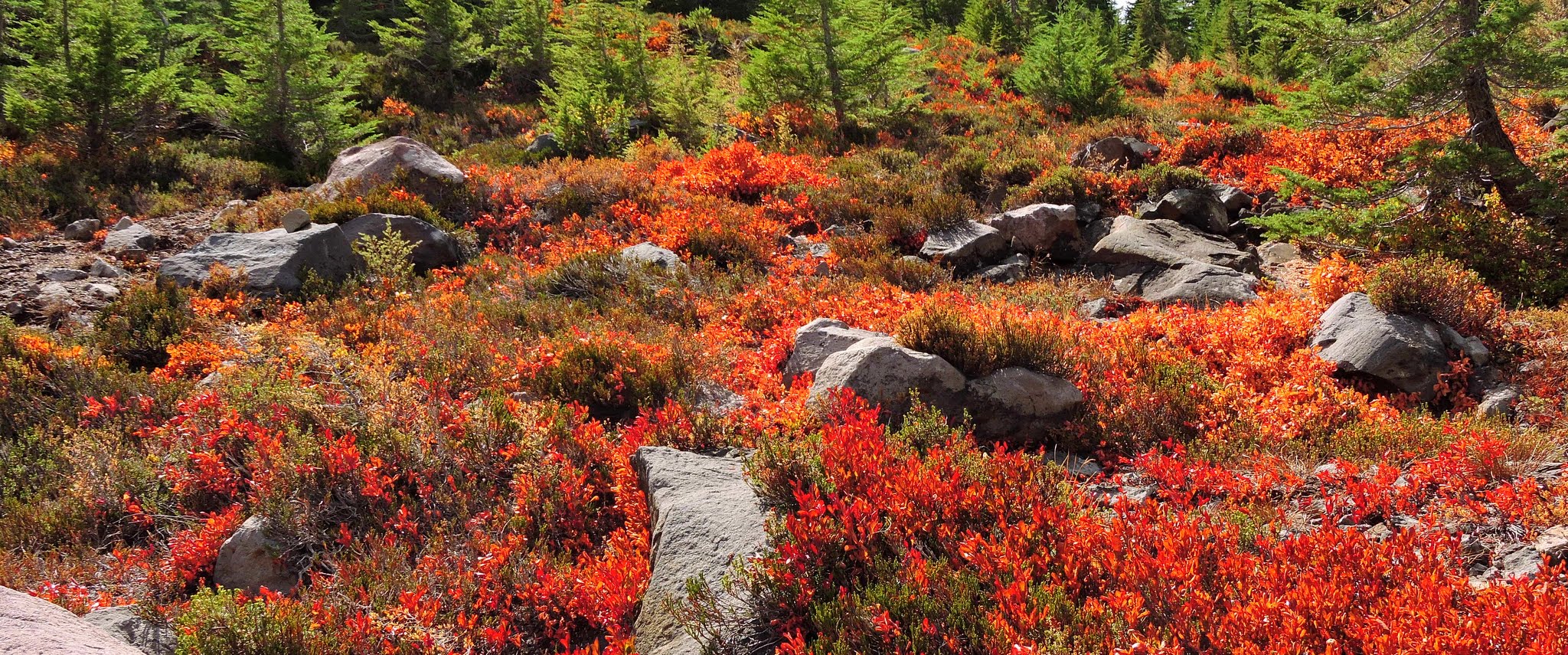Huckleberries are culturally and ecologically important plant species in the Northwest that are affected by climate change and land management practices. In the Northwest, the majority of huckleberry habitat is located on lands managed by the US Forest Service. Fire management and a warmer climate are changing where huckleberries can grow and when berries ripen, which affects wildlife, pollinators, and people who depend on them for food. Adaptive management is important to the long-term sustainability of huckleberries in the region as it uses lessons from past practices and prepares for future conditions.
We know that fire and forest management practices play important roles in the current and future success of huckleberries across the Northwest. As we learn more about huckleberry habitat, our ability to monitor huckleberry and adapt management over the short and long-term improves. Citizen scientists are already contributing to crowd-sourced location information that’s available to anyone and useful for research. Also, domesticating wild huckleberries could improve access and open up new economic opportunities for farmers. Below, you will find additional information on what we know about huckleberries in the Northwest and ongoing efforts for improved management and adaptation success.
Key Concepts
- Huckleberry habitat is expected to move to higher ground and may decrease overall, due to a warmer climate, fire suppression, and extreme fire.
- Huckleberries benefit from low-intensity fire but are vulnerable to intense fire that reduces overstory shade and increases plant competition.
- Higher seasonal temperatures could impact pollination and fruit production of huckleberry when flowering happens before pollinators (bees) are abundant.
- Research is underway to understand how forest management practices, such as thinning and prescribed fire, could impact huckleberry production.
- Domesticating wild huckleberry is a challenge, but may help to preserve access and improve economic opportunity.
Forest managers can maintain huckleberry habitat with brush clearing and low-intensity burning that creates forest gaps, while retaining overstory shade and improving soil conditions. Techniques for managing evergreen huckleberry with fire have been developed by the Karuk Tribe.
The US Forest Service and Tulalip Tribes document traditional knowledge and management of big huckleberry in the Mount Baker-Snoqualmie National Forest.
Predictive mapping of when, where, and how many huckleberries are seasonally available is in demand by harvesters and mangers. This information can help with long-term monitoring efforts. An ongoing case study in Glacier National Park is working to develop techniques that could be adopted in the Northwest region.
Growers can benefit from ongoing efforts to domesticate wild huckleberry. Huckleberries are nutrient-rich cousins of blueberries with higher sale value per pound. Commercial production could increase availability and economic potential for farmers in the Northwest.
Citizens, managers, and tribes can use and share huckleberry information that’s free to everyone and may advance science. A recent study used crowd sourced data to locate current habitat and predict where huckleberry might grow under future climate projections. The study found that huckleberry will likely move to higher ground and berries will ripen earlier in the year. These changes could impact pollination, cultural ties to traditional harvest locations, and the timing of harvest-related celebrations for regional tribes. Similar research used vegetation and climate models and also estimated significant habitat loss concentrated on the west side of the Cascades, with 15 percent loss by mid-century and 41 percent loss estimated for late-century simulations. A story map of the study highlights research outcomes and includes maps of potential future habitat .
-
USDA Natural Resources Conservation Service Plant Guide for black huckleberry.
The Northwest Huckleberry and Other Nuts and Berries of the Region. A story map that highlights several research outcomes, including maps that depict potential shifts for huckleberry and other wild fruits and nuts.
Huckleberries: Harbingers of Change is the title of Botany Brew's first podcast. The show discusses the implications of changes in the timing of the huckleberry life cycle that may be subtle but also notable to humans and wildlife.
Climate Change Shifts in Habitat Suitability and Phenology of Huckleberry (Vaccinium membranaceum). A research paper that provides fine-scale detail on methods and data sources used to model shifts in huckleberry range and timing of fruiting and flowering (associated with the story map above).
Evergreen Huckleberry / Púrith / Vaccinium ovatum. An information sheet on the important role of fire in huckleberry management from the Karuk Tribe.
Bears, Berries, and Bees: The Implications of Changing Phenology. A National Park study takes a close look at seasonal timing and productivity, with attention to key pollinator species for huckleberry.
Northwest Huckleberries Could be Close to Domestication. An article from Oregon Public Broadcasting about efforts to domesticate the Northwest huckleberry for farmers and gardeners.
Essential Guide for Successful Wildberry Farms in Southeast Alaska. A helpful manual for farmers and gardeners interested in growing wildberries in southeast Alaska.
Huckleberry and Ecology Management Research in the Pacific Northwest. A six-year study of Huckleberry management tactics in Oregon and Washington. The study addresses invasion of competing species and berry production improvement.
A social History of Wild Huckleberry Harvesting in the Pacific Northwest. A publication from the US Forest Service that details the development of the commercial huckleberry industry in the Northwest and addresses sustainable management.
Place of Mountain Huckleberries. A U.S. Forest Service and Tulalip Tribes Co-Stewardship Area.


